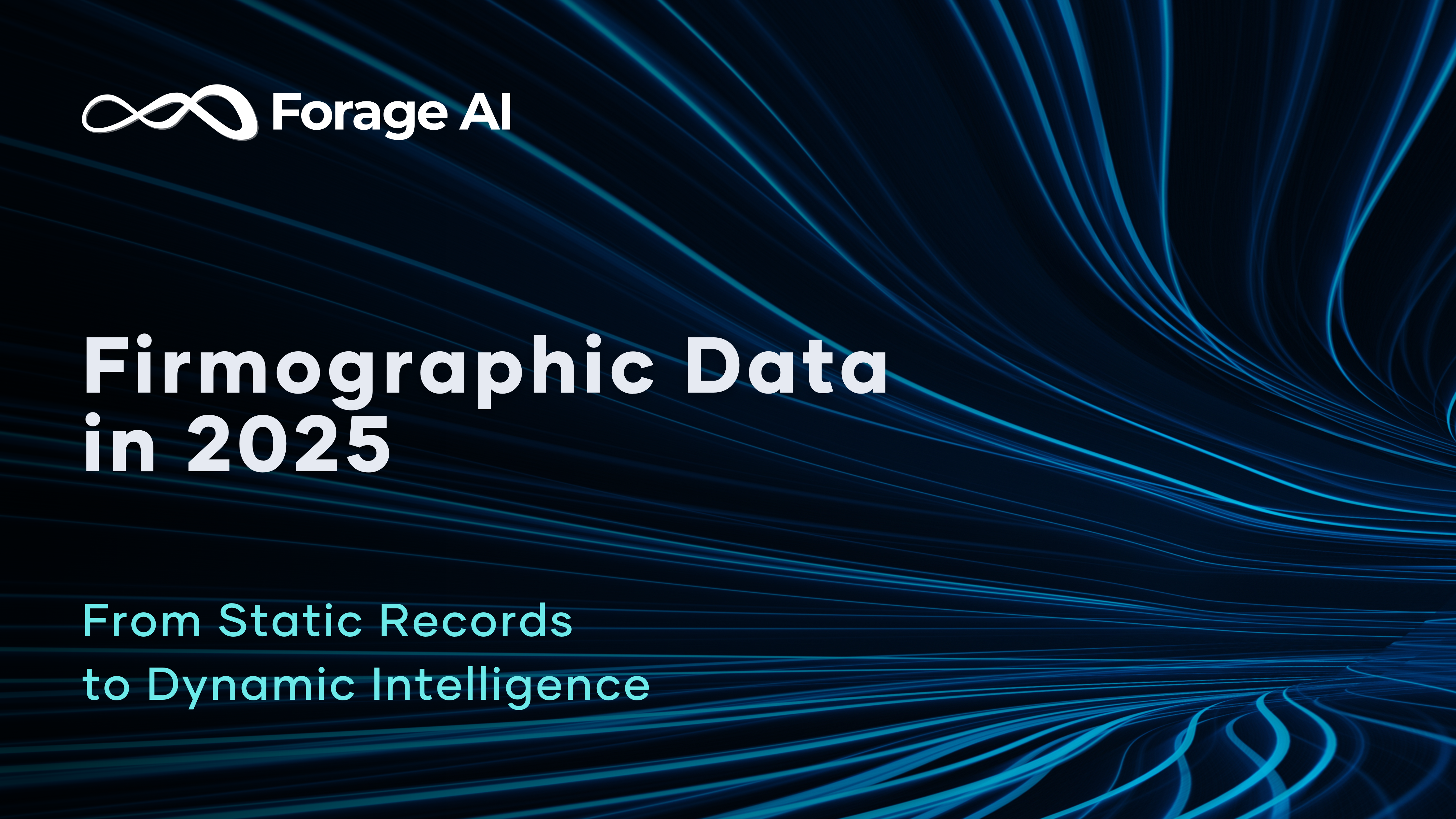The business landscape has fundamentally changed. According to MIT research, companies operating with real-time data capabilities achieve 62% higher revenue growth and 97% higher profit margins than their slower counterparts.
This stark reality has transformed firmographic data from static record-keeping into a dynamic engine powering strategic decision-making. As leading firmographic data providers, here at Forage AI, we’ve observed this evolution firsthand and helped organizations move from basic company profiling to sophisticated, AI-driven market intelligence. This shift isn’t just about having more data—it’s about having the right data at the right time to drive meaningful business outcomes.
To understand the full impact of this transformation, we need to examine how firmographic data has evolved and why traditional approaches no longer meet today’s business demands. Let’s start by looking at what limited organizations in the past and how modern solutions are reshaping market intelligence.
Traditional Firmographic Data: The Static Era
Not too long ago, a growing company’s entire view of its market fit into a single spreadsheet. Annual revenue, employee count, industry codes – these basic data points formed the backbone of B2B intelligence. Traditional firmographic segmentation relied on these basic metrics, and modern data integration tools were still in their infancy.
While these foundational metrics mattered, their static nature created significant blind spots for businesses trying to navigate an increasingly dynamic market landscape. Recent IBM research highlights this ongoing challenge, finding that 40% of enterprise organizations remain in the exploration and experimentation phases with their data, held back by data complexity and limited expertise.
Here’s a closer look at what limited traditional firmographic data’s effectiveness:
- Fragmented Information Collection:
- Vital company information existed across disconnected systems and databases.
- Teams maintained individual versions of supposedly “master” records.
- Cross-departmental data sharing happened quarterly – if at all.
- Building a unified view of any company meant piecing together mismatched puzzle pieces.
- Market intelligence stayed trapped in departmental silos.
- Time-Lagged Updates:
- Data updates followed rigid quarterly or annual cycles.
- Company milestones often surfaced months after they occurred.
- Market shifts became visible only after their impact hit.
- Strategic planning relied on historical snapshots instead of real-time intelligence.
- Competitive moves went unnoticed until well after execution.
- Limited Strategic Value:
- Standard industry classifications missed emerging business models.
- Revenue figures lacked context about growth trajectory.
- Employee counts told little about organizational maturity.
- Simple address listings couldn’t reveal actual market footprint.
- Technology stacks remained invisible in company profiles.
As markets accelerated and business models evolved, this static approach to firmographic data became a clear liability. Companies found themselves making million-dollar decisions using partial information that was often months out of date.
The market demanded a more sophisticated solution—one that could keep pace with modern business dynamics. Companies needed a firmographic intelligence system that not only updated in real time but also provided deeper context and predictive insights.
This shift from static records to dynamic intelligence required a fundamentally new approach—one powered by AI-driven automation. That’s exactly what we’ve built at Forage AI. By integrating real-time data streams, advanced analytics, and automated firmographic intelligence, we help businesses move beyond outdated spreadsheets and into a new era of market intelligence.
Intelligent Firmographic Data: The Dynamic Shift in 2025
Firmographic data has progressed from static snapshots into living insights that capture the full complexity of modern business. According to IDC predictions, the Global Datasphere will grow to 175 zettabytes in 2025, with 46% of the world’s stored data residing in public cloud environments. This massive shift in data volume and accessibility, combined with advances in AI in business intelligence and the integration of real-time business data streams and sophisticated application programming interfaces (APIs), has redefined what’s possible in B2B market intelligence.
Here’s how intelligent firmographic data operates in today’s landscape:
Live Market Monitoring:
- Smart monitoring systems detect and verify company changes in real-time.
- Multiple data streams cross-validate information for accuracy.
- Algorithms spot significant market shifts as they emerge.
- Companies receive alerts about meaningful changes, not just data updates.
- Historical patterns provide context for current developments.
- Enhanced Contextual Understanding:
- Growth metrics reveal velocity, as well as a company’s size.
- Investment patterns indicate market confidence and sector health.
- Tech adoption rates indicate operational sophistication and maturity.
- Regional growth patterns reveal strategic market decisions.
- Partnership networks map business ecosystems.
- Predictive Capabilities:
- AI models reveal emerging market opportunities before they become obvious.
- Risk models identify potential disruptions early.
- Partnership scoring highlights strategic fit potential.
- Market movement analysis reveals sector trends.
- Competitive intelligence forecasts strategic shifts.
- Growth modeling projects company trajectories.
- Adaptive Frameworks:
- API integration allows organizations to tailor data feeds to specific needs.
- Modular solutions enable selective data access based on business priorities.
- Customizable reporting tools generate insights aligned with strategic objectives.
- Scalable architecture supports growing data requirements.
This shift from static records to dynamic intelligence marks a fundamental change in how businesses understand their markets. Today’s companies need data that moves as fast as the markets they operate in. Forage AI empowers businesses with firmographic intelligence that does just that—delivering real-time updates on company performance, competitor strategies, and emerging trends.
As we’ll explore next, our APIs play a central role in making this intelligence actionable across organizations.
The Role of APIs in Delivering Actionable Insights
Before APIs revolutionized data access, analysts spent hours downloading reports and manually updating spreadsheets to piece together market intelligence. These delays left companies relying on outdated data, reacting to market shifts after they had already happened. Businesses today require an automated, scalable way to integrate real-time firmographic insights directly into their workflows.
That’s exactly what Forage AI’s API-driven solutions enable. Our firmographic data APIs seamlessly integrates into CRM and analytics platforms, ensuring every update is reflected instantly across all systems. Through standardized APIs for firmographic insights, organizations can automate data flows, customize implementations, and maintain real-time synchronization across their entire tech stack.
Here’s how APIs transform firmographic data delivery:
1. Integration Made Easy
The days of juggling multiple platforms and manual exports are over. Our APIs enable:
- Direct embedding of firmographic data into existing business systems
- Automatic synchronization between platforms
- Standardized data formats for consistent processing
- Built-in data validation and error handling
- Real-time updates across all connected systems
2. Automated Workflows
APIs eliminate manual processes by creating intelligent, self-maintaining data flows:
- Custom webhooks trigger actions based on specific data changes
- Bi-directional data sync keeps systems aligned
- Automated data enrichment as new information becomes available
- Configurable alerts for significant changes
- Scheduled bulk updates for resource-intensive operations
3. Customizable Implementation Models
Our flexible API system adapts to your organization’s unique needs:
- Start small and scale up as your needs grow
- Choose how you want to receive and send data
- Control who has access to what information
- Test changes safely before going live
- Access clear documentation and dedicated support
4. Enterprise-Grade Security and Compliance
We ensure your data stays protected:
- Industry-standard security protocols
- Secure authentication systems
- Fine-grained control over user permissions
- Complete tracking of who accessed what and when
- Full compliance with privacy regulations like GDPR and CCPA
- Built-in protections against system overload and misuse
APIs serve as the vital pipeline through which firmographic intelligence flows, converting raw data into actionable insights. This combination redefines how businesses operate—enabling teams to spot opportunities, respond to changes, and make decisions with unprecedented speed and confidence. As markets accelerate, this capability isn’t just an advantage—it’s becoming essential for survival.
How Modern Firmographic Data Drives Business Decisions
The shift from static reports to active intelligence fundamentally changes how organizations make decisions. Instead of relying on quarterly reviews and annual planning cycles, modern businesses can now operate in a continuous decision-making environment where strategy evolves with the market.
This transformation manifests in three key areas:
Strategic Timing
Traditional business decisions followed rigid timelines—annual budgets, quarterly reviews, and monthly reports. Today’s firmographic intelligence enables a more dynamic approach:
- Strategic moves can be timed to market conditions rather than calendar dates.
- Resources can be reallocated as opportunities emerge.
- Investments can be adjusted based on real-time market signals.
- Expansion plans can flex with changing market conditions.
Decision Confidence
Modern firmographic data transforms how leaders evaluate choices:
- Decisions are backed by verified, current market data rather than assumptions.
- Multiple data points provide cross-validation of market trends.
- Historical patterns provide context for current decisions.
- Market signals help quantify risks and opportunities.
Stakeholder Alignment
Real-time intelligence creates new possibilities for organizational alignment:
- All stakeholders work from the same current market view
- Decision rationale can be clearly communicated with supporting data
- Strategy adjustments can be quickly validated across departments
- Market changes are visible to everyone simultaneously
By shifting from static reports to active intelligence, companies can improve how they approach market opportunities. The focus moves from reacting to changes to anticipating them, creating space for proactive strategy development. This evolution in decision-making capability equips organizations with the tools they need to thrive in fast-moving markets.
Real-World Examples of Data Transformation
As we’ll see in the following examples, different industries are leveraging these capabilities in unique ways to transform their operations.
Technology and SaaS
SaaS companies are transforming their growth strategies:
- Identifying regional market saturation points to guide expansion timing
- Spotting customer behavior patterns that indicate readiness for product upgrades
- Using competitive intelligence to refine pricing and feature offerings
Healthcare
Healthcare providers and suppliers use firmographic intelligence to guide expansion:
- Automated monitoring identifies clinics adding new services, helping medical equipment providers spot sales opportunities.
- Predictive tools analyze regional healthcare trends, improving resource allocation decisions.
Retail and E-commerce
Retailers are revolutionizing their approach to partnerships and expansion:
- Smart data analysis enables targeted product recommendations for retail partnerships.
- Instant updates on franchise developments help vendors identify new market opportunities.
Manufacturing
Manufacturing firms leverage firmographic insights across their operations:
- Predictive analytics enhance supply chain decisions by spotting potential disruptions early.
- Market analysis identifies growing mid-sized companies ready for supplier relationships.
Each industry finds unique value in firmographic data, but one theme remains constant: the move from reactive to predictive decision-making. This shift helps organizations stay ahead of market changes rather than responding to them after the fact.
While these applications are transforming businesses today, emerging technologies are opening new possibilities for tomorrow.
Future Trends: Where Firmographic Data Is Heading
As technology advances, firmographic data continues to evolve. Recent IBM research reveals that 59% of organizations already exploring or deploying AI have accelerated their investments in the technology, signaling a clear direction for the future of market intelligence and intelligent data transformation. Three key developments are reshaping how organizations will use this intelligence:
AI-Driven Insights at Scale
AI is pushing the boundaries of what’s possible with firmographic data. Machine learning models now process vast amounts of market information to spot patterns humans might miss. These systems will soon:
- Generate more accurate market projections.
- Uncover subtle business opportunities.
- Predict market shifts earlier.
- Automate complex market analysis.
- Provide deeper competitive insights.
Hyper-Specific Metrics
Tomorrow’s firmographic data extends beyond traditional business metrics. New data points are emerging that paint a more complete picture of company performance:
- ESG (Environmental, Social, Governance) scores
- Innovation metrics
- Digital transformation indicators
- Workforce dynamics
- Market influence measurements
Market Network Intelligence
Traditional market analysis focused on companies in isolation. Tomorrow’s firmographic systems will map complex webs of business relationships and market dynamics, enabling organizations to understand and predict how changes ripple through entire industries:
- Cross-industry impact analysis reveals hidden market dependencies
- Ecosystem modeling predicts ripple effects of market changes
- Multi-dimensional relationship mapping uncovers strategic opportunities
- Real-time market simulation enables scenario testing
These advances aren’t just making firmographic data more detailed – they will further transform how businesses understand and respond to market opportunities.
Final Thoughts: The Evolution Continues
As APIs, AI, and advanced analytics continue to redefine market intelligence, the gap between static data and dynamic, real-time insights is only growing wider. Businesses that fail to adapt risk making decisions based on outdated or incomplete information—while their competitors move ahead with predictive intelligence.
At Forage AI, we’re bridging this gap. Our AI-powered firmographic intelligence solutions ensure you have the most accurate, real-time insights at your fingertips—so you can act faster, strategize smarter, and stay ahead of market shifts before they happen.
Don’t let outdated data hold your business back. If you’re ready to elevate your market intelligence, talk to our experts today. Let’s build a firmographic intelligence pipeline that keeps you ahead of every market change.





